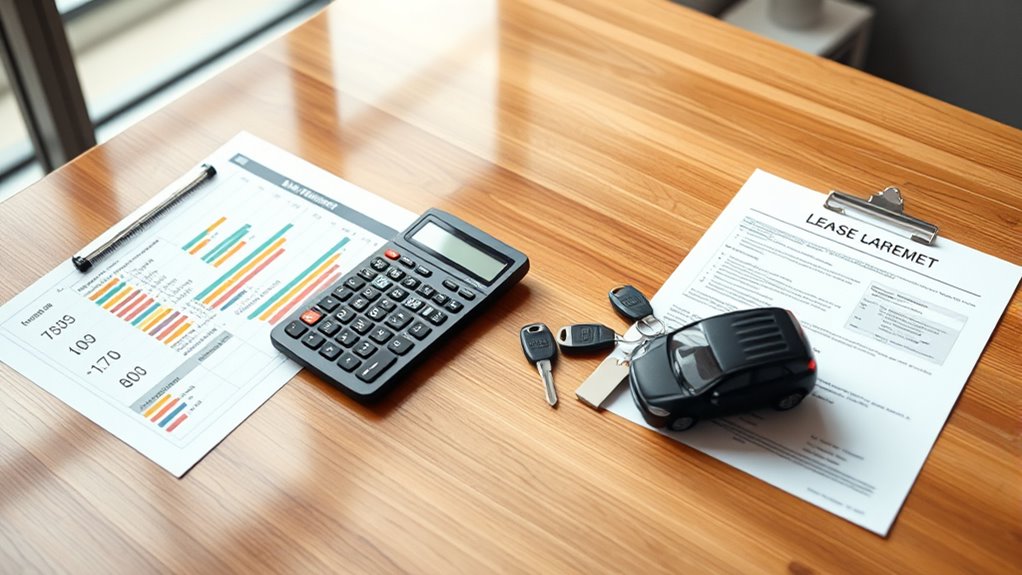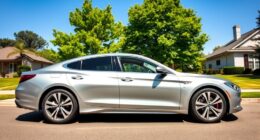To compare leasing versus buying, start by calculating your total lease costs, including monthly payments, fees, taxes, and any incentives or upfront costs. For buying, consider the purchase price, financing interest, depreciation, taxes, and estimated resale value. Factor in maintenance and insurance costs for both options. By summing these expenses over your intended ownership period, you’ll get a clear picture of which option fits your finances best. Keep going to discover more helpful tips.
Key Takeaways
- Include all upfront costs, such as down payments or incentives, and ongoing payments like lease or loan installments.
- Calculate total depreciation, interest, taxes, registration, and insurance expenses over the ownership or lease period.
- For leasing, factor in residual value, lease incentives, and any potential end-of-lease costs.
- For buying, consider the total loan interest, depreciation loss, and potential resale or trade-in value.
- Compare long-term costs after loan payoff or lease end to determine which option is more economical.

Deciding whether to lease or buy a vehicle can substantially impact your finances, but making the right choice requires understanding the true costs involved. When you’re exploring leasing options, you’ll notice that many dealerships offer lease incentives to attract customers. These incentives can lower your monthly payments or reduce the initial costs, making leasing seem more appealing upfront. However, it’s essential to look beyond these offers and consider how depreciation methods affect the overall cost. Lease agreements typically base payments on the vehicle’s expected depreciation over the lease term. If the manufacturer’s chosen depreciation method assumes a higher depreciation rate, your lease payments might be higher. Conversely, favorable depreciation methods or incentives could reduce your costs, but it’s vital to understand how these factors influence your total expenditure over time.
Leasing often requires less upfront cash, which can be attractive if you prefer to preserve cash flow or want to drive a newer vehicle every few years. But remember, lease payments mainly cover the vehicle’s depreciation and a portion of the interest, not the vehicle’s entire value. This means you’re effectively paying for the depreciation during the lease period, and at the end, you return the vehicle without building equity. If you plan to keep a vehicle long-term, buying might be more cost-effective because you’re paying off the entire purchase price and eventually owning the asset. In that case, you’ll need to consider factors like loan interest rates, vehicle depreciation, and potential trade-in value.
Leasing costs mainly cover depreciation, with no equity building—buying offers long-term ownership benefits.
When calculating the total cost, don’t forget to include other expenses such as taxes, registration, insurance, and maintenance. Leasing may include some maintenance plans, but you’ll still be responsible for ongoing costs. Buying might have higher initial costs, especially with a larger down payment, but over time, you can benefit from reduced monthly expenses once the loan is paid off. Additionally, the method used to calculate depreciation directly impacts your buyout options and the vehicle’s resale value. Knowing how depreciation methods are applied can help you predict how much value your car will retain and plan your finances accordingly.
Ultimately, the decision between leasing and buying hinges on your financial goals, driving habits, and how long you want to keep the vehicle. Leasing can provide lower monthly payments and access to newer models, but buying offers long-term value and ownership. Carefully reviewing lease incentives and understanding depreciation methods will help you accurately compare costs and make an informed decision aligned with your budget.
Frequently Asked Questions
How Does Lease-End Residual Value Affect Total Costs?
The lease-end residual value directly impacts your total costs because it determines the amount you owe if you choose to buy the vehicle. A higher residual value means less depreciation during the lease, lowering your monthly payments. Conversely, a lower residual value increases lease depreciation, raising costs. Understanding the residual value helps you evaluate whether leasing remains cost-effective compared to buying, as it affects your overall financial commitment.
Are There Tax Implications for Leasing Versus Buying?
Think of your decision as planting seeds for future growth. When you lease, you may enjoy tax benefits through deductions on lease payments, but depreciation rules favor buyers, offering potential tax advantages on ownership. Leasing often provides simpler tax implications, while buying could mean more complex depreciation benefits. Your choice affects your financial landscape—consider how tax benefits align with your long-term goals and consult a tax professional for clarity.
What Is the Impact of Early Termination Fees?
When you face an early termination, you’ll likely pay a lease penalty that covers the residual risk the lender or leasing company assumes. This fee compensates for potential depreciation or remaining lease obligations. Early termination can considerably increase your overall costs, so consider how a lease penalty might impact your finances before ending the agreement prematurely. Being aware of these fees helps you make informed decisions and avoid unexpected expenses.
How Do Maintenance Costs Differ Between Leasing and Buying?
When it comes to maintenance costs, leasing usually covers regular lease maintenance, meaning you don’t pay for most repairs. However, with ownership repairs, you’re on your own, which can add up over time. Think of it as the difference between a smooth ride and fixing the engine yourself. You’ll find that lease maintenance is predictable, while ownership repairs can be unpredictable, making it essential to budget accordingly for both.
What Credit Score Requirements Influence Lease or Purchase Options?
Your credit score directly impacts your financing options for both leasing and buying. A higher score can qualify you for better lease terms, lower interest rates, and more favorable purchase loans. Conversely, a lower credit score might limit your options, increase your costs, or even prevent approval. To improve your chances, check your credit score early and work on boosting it, which helps you secure more advantageous leasing and purchasing deals.
Conclusion
So, as you weigh your options, think of leasing as a gentle stream—easy to navigate but fleeting—while buying is a sturdy river, carving its own path. The choice depends on whether you prefer the freedom of short-term ease or the deep satisfaction of ownership. Whichever route you take, remember that understanding the costs helps you steer clear of hidden rapids and enjoy a smooth ride on your financial journey.









